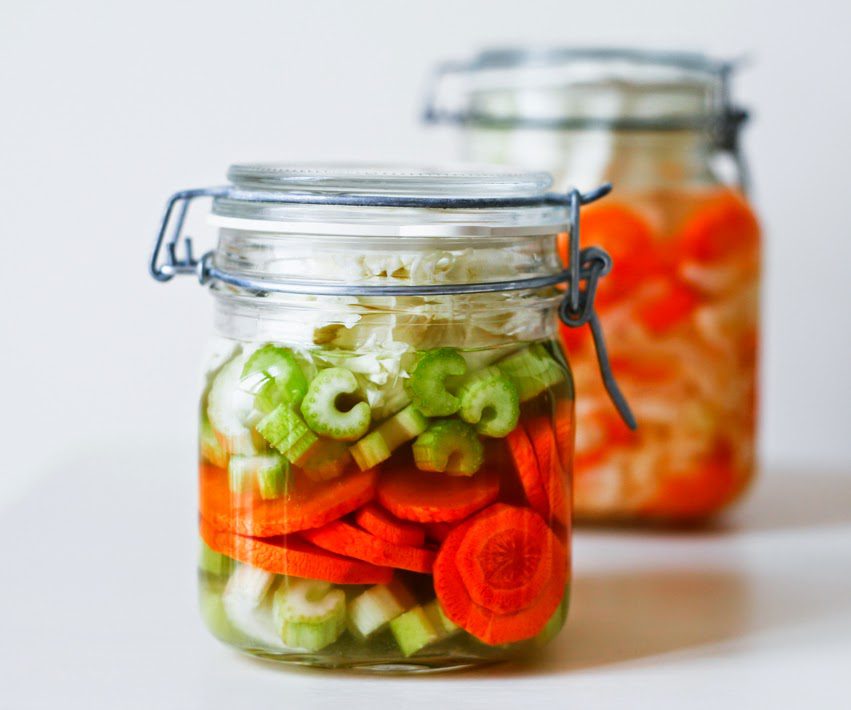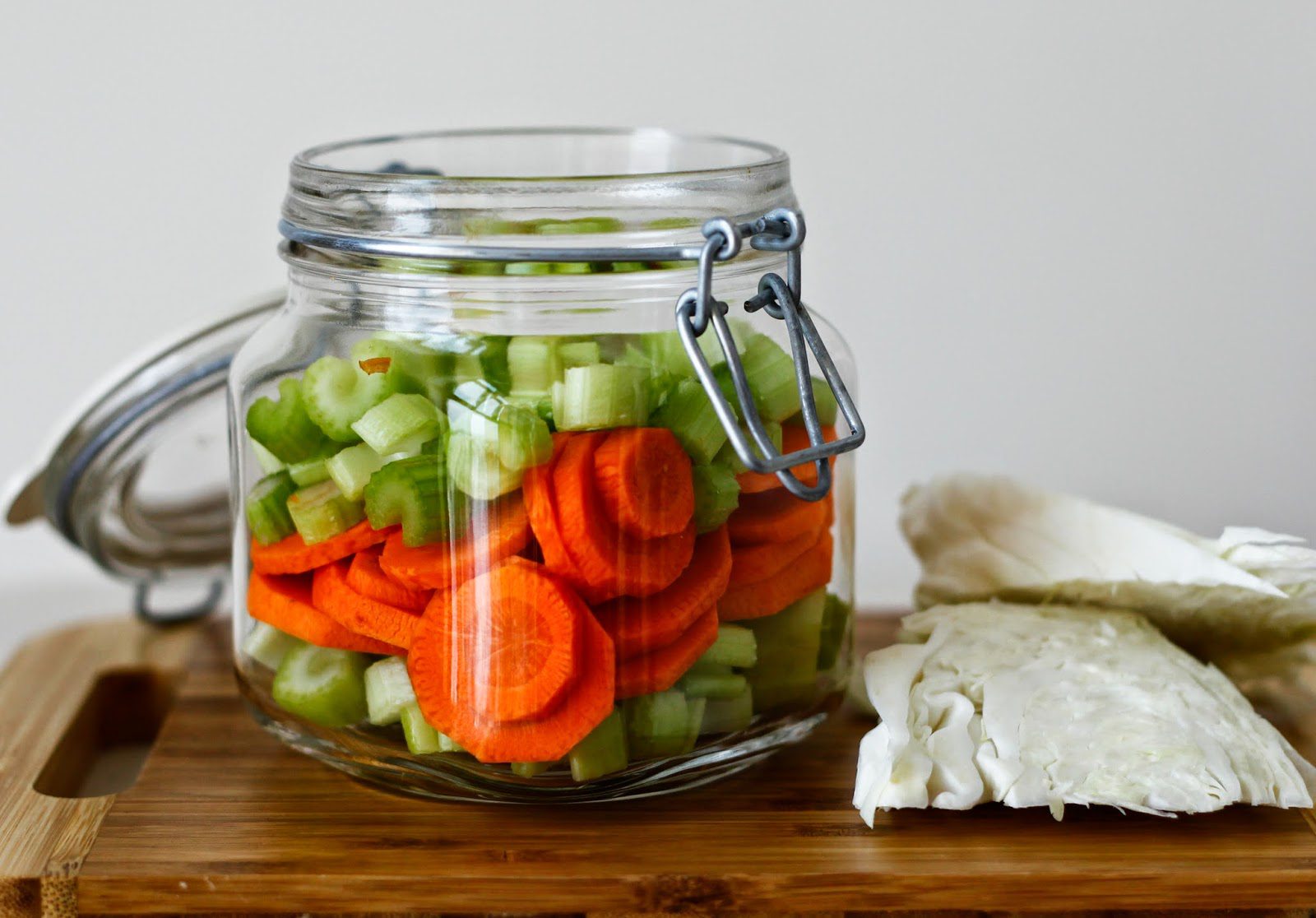
Lacto-Fermented Carrot and Celery
Does anyone else end up buying a whole bunch of celery (because it works out much cheaper than buying half), using a few stalks and have the rest wilting in the fridge? This happens to me a lot! I tend to forget the remainder in the bottom of the fridge until its clean out time. I now have the perfect thing to do with the remainder of my celery!
Fermenting the celery still maintains it’s crunch, and the sourness just adds so much more flavour to it. My old high school friend Michelle mentioned to me how her mum used to make fermented (pickled) carrot and celery at home. I thought I would try it out since they are 2 vegetables I seem to always have on hand and I was going away last week so I had to clear out the fridge. I came back home to a yummy surprise!
 |
| Lacto-Fermented Carrot and Celery |
- 1 litre (1 Quart size approx) Jar with Flip Top lid/lock (e.g. Fido Jar)
- 1 to 2 medium carrots
- 4 celery stalks
- 1 litre clean filtered water (boiled and cooled if unsure)
- 2-3 tbsp natural sea salt
- 1 sachet Body Ecology Veggie Culture Starter optional and 1/2 tsp organic sugar
- 2 cabbage outer leaves or cut 2 wedges of cabbage (all the cabbages seem to have the outer leaves removed over here so I have been using wedges of cabbage, they end up fermented too so I also eat them with the vegetables)
 |
| Lacto-Fermented Carrot and Celery |
 |
| Use the cabbage wedges (or outer cabbage leaves) to keep the veggies pushed under the brine |
Method Using Culture Starter:
- Take the culture starter sachet out of the fridge to allow it to come to room temperature
- Clean the jar and all utensils (knife, board) with hot water and vinegar and sit on a dish rack or clean tea towel to air dry
- Wash the carrots and celery and sit on a clean tea towel to dry
- In a small glass, add some of the water and dissolve halve a tsp of organic sugar (if using the Culture starter, skip if not)
- Empty the sachet into the glass to allow the bacteria to wake up and start feeding on the sugar
- Peel and slice the carrots about 4-5mm thick
- Slice the celery a little thicker than the carrots
- Fill the jar up with the carrots and celery leaving 1 inch from the top, press the vegetables down using your hands
- Make a brine by dissolving 1 tsp salt with the water, then add the culture starter mixture (salt is used to inhibit the growth of bad bacteria to give the good bacteria a good start to do their thing. Using a culture starter allows you to use less salt, if you prefer softer veggies you can reduce the salt further, increase the salt for more crunch)
- Pour the brine over the vegetables until just covered
- Roll up each cabbage leaf (or place the cabbage wedges) and place on top of the vegetables to keep them under the brine
- Keep the jar on the counter out of the sun or in a cupboard for 5-7 days, they should keep for well over 6 months
- Once opened, store them in the fridge
- Don’t forget to always use clean utensils – no fingers! this will keep your jar lasting a lot longer once it is opened.
 |
| Lacto-Fermented Carrot and Celery |
- Clean the jar and all utensils (knife, board) with hot water and vinegar and sit on a dish rack or clean tea towel to air dry
- Wash the carrots and celery and sit on a clean tea towel to dry
- Peel and slice the carrots about 4-5mm thick
- Slice the celery a little thicker than the carrots
- Fill the jar up with the carrots and celery leaving 1 inch from the top, press the vegetables down using your hands
- Make a brine by dissolving approximately 2-3 tbsp salt with the water (not all salts are the same so you can adjust the salt to your taste but remember salt is used to inhibit the growth of bad bacteria to give the good bacteria naturally present in the veggies a good start to do their thing, if you prefer softer veggies you can reduce the salt. Too much salt can inhibit all the bacteria and the veggies won’t ferment so I do not recommend using anymore than 3 tbsp per litre of water or any less than 2 tbsp without a culture starter)
- Pour the brine over the vegetables until just covered
- Roll up each cabbage leaf (or place the cabbage wedges) and place on top of the vegetables to keep them under the brine
- Keep the jar on the counter out of the sun or in a cupboard for 5-7 days, they should keep for well over 6 months
- Once opened, store them in the fridge
- Don’t forget to always use clean utensils – no fingers! this will keep your jar lasting a lot longer once it is opened.
PS. If you live in Australia, you can order your Body Ecology products from here. Enter discount code ‘loveurbelly’ for 5% off or order direct from Body Ecology USA.
I really recommend the below books if you want to know more about fermentation, I found them really useful when I first started out:
Nourishing Traditions by Sally Fallon
The Art of Fermentation by Sandor Katz
Wild Fermentation by Sandor Katz
The Body Ecology Diet by Donna Gates
- 1 litre (1 Quart size approx) Jar with Flip Top lid/lock (e.g. Fido Jar)
- 1 to 2 medium carrots
- 4 celery stalks
- 1 litre clean filtered water (boiled and cooled if unsure)
- 2-3 tbsp natural sea salt
- 1 sachet Body Ecology Veggie Culture Starter optional and ½ tsp organic sugar
- 2 cabbage outer leaves or cut 2 wedges of cabbage (all the cabbages seem to have the outer leaves removed over here so I have been using wedges of cabbage, they end up fermented too so I also eat them with the vegetables)
- Take the culture starter sachet out of the fridge to allow it to come to room temperature
- Clean the jar and all utensils (knife, board) with hot water and vinegar and sit on a dish rack or clean tea towel to air dry
- Wash the carrots and celery and sit on a clean tea towel to dry
- In a small glass, add some of the water and dissolve halve a tsp of organic sugar (if using the Culture starter, skip if not)
- Empty the sachet into the glass to allow the bacteria to wake up and start feeding on the sugar
- Peel and slice the carrots about 4-5mm thick
- Slice the celery a little thicker than the carrots
- Fill the jar up with the carrots and celery leaving 1 inch from the top, press the vegetables down using your hands
- Make a brine by dissolving 1 tsp salt with the water, then add the culture starter mixture (salt is used to inhibit the growth of bad bacteria to give the good bacteria a good start to do their thing. Using a culture starter allows you to use less salt, if you prefer softer veggies you can reduce the salt further, increase the salt for more crunch)
- Pour the brine over the vegetables until just covered
- Roll up each cabbage leaf (or place the cabbage wedges) and place on top of the vegetables to keep them under the brine
- Keep the jar on the counter out of the sun or in a cupboard for 5-7 days, they should keep for well over 6 months
- Once opened, store them in the fridge
- Don't forget to always use clean utensils - no fingers! this will keep your jar lasting a lot longer once it is opened.



